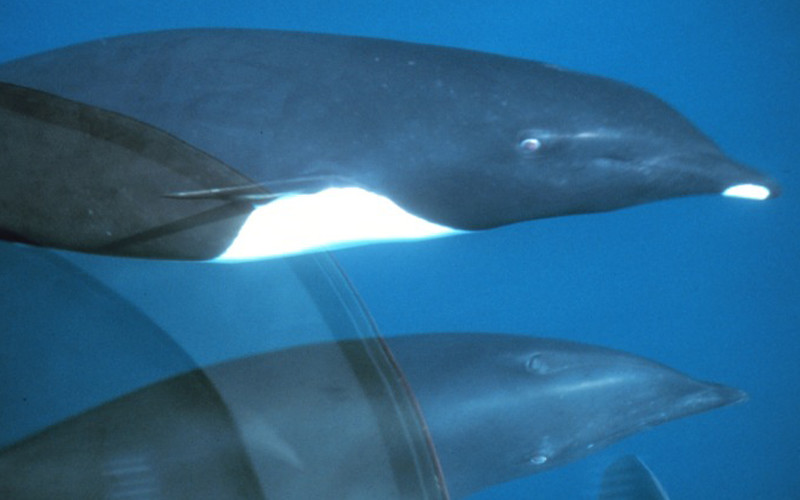Lissodelphis borealis
INFORMATION AND CHARACTERISTICS.
The Northern right whale dolphin and its close relative the southern right whale dolphin (Lissodelphis peronii), are the only dolphin species of the family Lissodelphis that lack a dorsal fin. The naturalist Titian Peale was the first to describe this species in 1848. Its scientific name comes from word Lissos that means “soft” in Greek, and the Latin borealis which means “north.”
HOW DO THEY LOOK? PHYSICAL CHARACTERISTICS.
Morphology.
The slender, hydrodynamic body of the northern right whale dolphin allows it to reach great speed when swimming. Both species of the genus Lissodelphis are the thinnest of all the small cetaceans, and this, in particular, is endowed with a short “snout” and a tilted forehead, both separated by a fold. It has no dorsal fin but has two small, curved and pointed pectoral flippers.
Order: Cetacea
Family: Delphinidae
Genus: Lissodelphis
Weight and size.
Usually, males are larger and heavier than females. An adult male individual measures approximately 3.1 meters in length but the range of the female is 2.3-2.6 meters. The weight oscillates between 60 and 100 kilograms.
Skin Coloration.
The shining dolphin’s skin has a dark color on the dorsal area that contrasts with the white belly, however, this is little visible. Under the lower jaw, it has a white spot. Both the pectoral flippers and the caudal fin are black.
Distinctive characteristics.
It is easy to distinguish this dolphin from other species, but it can be confused with sea lions because of the lack of dorsal fin. It is necessary to observe the dorsum and the coloring pattern characterized by black and white to avoid confusion with other animals.
WHERE DO THEY LIVE? DISTRIBUTION AND HABITAT.
The Northern right whale dolphin has a limited distribution. It is found only in temperate and cold waters of the North Pacific Ocean between latitudes 30° and 50° north. They inhabit from northern Baja California in Mexico to the Gulf of Alaska, and in the west from Kamchatka in Russia to Japan. It is present in Russia, Mexico, the United States, Canada, and Japan.
It inhabits waters of the platform and the continental slope of great depth as well as (occasionally) areas near the coasts as long as they are deep. The temperature of its habitat is generally below 19° C but can tolerate those equal to or less than 24° C.
WHAT DO THEY EAT? DIET AND EATING HABITS.
Fish and cephalopods make up most of the diet of this carnivorous dolphin. It feeds on a wide variety of species. Some of its favorite prey are:
– Lanternfish (myctophids).
– Hake.
– Saury (family Scomberesocidae).
– Octopus.
– Squid.
When they inhabit around the center of the Pacific Ocean, the lanternfish make up the prey most consumed by this dolphin.
HOW DO THEY BEHAVE? BEHAVIOR.
The Northern right whale dolphin is very gregarious and creates pods quite large. They are comprised of 100-200 dolphins although the most common number is 200. However, sometimes they form superpods up to 2,000-3,000 individuals. The organization of such pods is somehow similar to some birds; they can travel forming a V.
It often associates with other dolphins and marine mammals, especially the Pacific white-sided dolphin (Lagenorhynchus obliquidens) and the Risso dolphin (Grampus griseus). It swims very fast, and its average speed is about 25 kilometers per hour, but it has speed bursts up to 40 kilometers per hour.
Sometimes the pod creates disturbance in the surface of the water due to its acrobatics, jumps, splashes with the tail and belly. It is also a little nervous and if something disturbs it, then flees immediately.
There are reports of seasonal migrations triggered by changes in water temperature. During spring and summer, the southernmost individuals travel to the north, and the northern ones migrate south.
HOW DO THEY REPRODUCE? MATING AND REPRODUCTION.
Data on the reproductive habits of this cetacean are very scarce. They reach sexual maturity between 9.7 and 9.9 years of age, being the later in males. In the winter-early spring period, there is more birth frequency, but other researchers believe that most births occur during the summer months, between July and August.
The female gives birth every 2 or more years to one offspring whose length is 0.8-1 meter.
WHAT IS THEIR CONSERVATION STATUS? THREATS AND CONSERVATION.
Conservation Status: “Least Concern.”
The conservation state of this dolphin is “Least Concern” on the Red List of the International Union for the Conservation of Nature (IUCN). A few years ago thousands of Northern right whale dolphins (Lissodelphis borealis) were killed annually in waters of Japan, Korea, and Taiwan as result of bycatch. Today, the number of deaths has reduced, but gillnets, direct harpoon hunting and contamination of its habitat still threaten the survival of this dolphin.
Efforts to preserve this dolphin involve its inclusion in Appendix II of CITES (Convention on International Trade in Endangered Species of Wild Fauna and Flora) and taking the measures recommended by the Pacific Offshore Cetacean Take Reduction Team of the National Marine Fisheries Service (NMFS) to reduce incidental fishing mortality.
References
Annalisa Berta. Whales, Dolphins, and Porpoises: A Natural History and Species Guide. University of Chicago Press, 2015.
http://www.iucnredlist.org/details/12125/0
http://www.nmfs.noaa.gov/pr/species/mammals/cetaceans/northernrightwhaledolphin.htm

